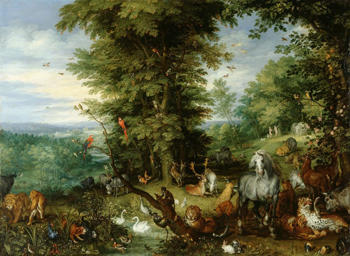
The Sacred Garden
‘Amiddes the garden so much delectable
There was an herber fayre and quadrante
To paradyse right well comparable
Set all about with flours fragrante;Stephen Hawes (b. c.1475 – d. before 1511), from The Pastime of Pleasure (1509)

Adam and Eve in the Garden of Eden, 1615 by Jan Brueghel ©
Throughout the Middle Ages, garden images in western Europe were found exclusively in illuminated manuscripts. These images depicted sacred gardens from the Old and New Testament, particularly the Garden of Eden. The Book of Genesis provided a detailed framework for illuminators’ depictions of the Garden of Eden. The established conventions were then followed by printmakers after the advent of print technology in the late fifteenth century. Many features from the medieval garden (the turf bench, the tunnel arbour, the fountain) which were depicted in imagery of the sacred garden, also appeared in images of secular gardens, which began to gain in popularity in the fifteenth century. Even so, the gardens portrayed sprang from the imagination, rather than accurately representing existing gardens of the time.
The late-fourteenth century saw the development in northern Italy and the Holy Roman Empire of a type of painting representing the enclosed garden (hortus conclusus) of the Virgin Mary. The use of the garden to convey symbolic meaning in sacred or secular art became such a deeply embedded practice that it was not until the sixteenth century that images of real gardens began to appear.
After Master of Hoogstraten (early 16th century)
The Virgin and Child with Saints Catherine and Barbara
Jan Brueghel the Elder (Brussels 1568-Antwerp 1625)
Adam and Eve in the Garden of Eden
Rembrandt van Rijn (Leiden 1606-Amsterdam 1669)


